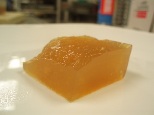 Rabbi Avrohom Mushell, Star-K Kashrus Administrator
Rabbi Avrohom Mushell, Star-K Kashrus Administrator
Have you ever had a slice of Petcha, gala reta that spicy globby stuff Bubby used to cook up. How did she manage to make it so thick?
Better yet, open a can of gefilte fish. Look at the stiff jell that comes as its broth. Why When you cook your own gefilte fish, do you not get that solid jelly from your broth?
Did you ever wonder why theirs is so thick and yours is not?
COLLAGEN is the answer to this thickening question.
Collagen is a fibrous insoluble protein that makes up a major portion of bone, skin and connective tissue. By cooking animal bones or adding fish bones to the broth of your gefilte fish, you will extract some of the collagen from the bones. This gives you the wobbly jelly in Petcha or the gefilte fish that comes in a can.
The most common form that collagen is marketed to us is in its partially hydrolyzed state known commonly as gelatin. The word gelatin comes from the Latin word gelatus, meaning stiff or frozen. Gelatin stiffness is measured in units called Bloom. This refers to a measuring device developed by a man named Oscar T. Bloom. High bloom refers to a higher molecular weight of the gelatin giving a stiffer consistency. Different applications will require different bloom levels.
Gelatin Uses
Gel Desserts
Ice Creams
Gummy Bears
Throat Lozenges
Low Fat Items
Sugar Glazes
Emulsifiers
Marshmallows
Toffees
Vitamins
Frostings
Capsules
Yogurts
Protein Supplements
With the commercialization of food processing, this versatile ingredient has shown its usefulness in a variety of foods. We may be well aware of its use in making jellylike confections from Jell-O to Gummy Bears. But the usefulness of gelatin goes beyond that. Gelatin is fat free, yet it leaves a smooth feeling in your mouth similar to that of fat. This effect is very useful as an additive to foods that are marketed as low fat. Gelatin also acts as an emulsifier helping to distribute fat and add stability to confections. This is helpful in toffees or in spreadable frostings, creams, yogurts and ice creams. Adding gelatin can make a candy last longer as gelatin does not break down as quickly as sugars do. This makes the addition of gelatin ideal for throat lozenges. Similarly hard sugar glazes will stay white and not run when gelatin is added. Gelatin can hold shape when aerated to create light and fluffy marshmallows. In vitamins and medicines gelatin can be used as a coating to cover a bitter taste or as a capsule to contain the powders. Some use plain gelatin as a protein supplement to their diet. All in all, gelatin is remarkably versatile and ideal for the manufacture of many processed foods and confections. The only question to the kosher consumer is, can one use foods containing gelatin?
The answer, in short, is it depends on the source. As mentioned before, gelatin is made by extracting the collagen from the bones and skins of animals and fish. Most commonly, the gelatin made from animal products is not being manufactured from kosher or Kosher-slaughtered animals. There are several questions that must be addressed to understand the Halachic status of gelatin. For starters the Torah prohibits eating the meat of those animals or fish designated as tameh (unclean/non-kosher). Examples are, pig, horse, catfish, and shark. Meat of an animal that is tahor (clean/kosher) and is not properly slaughtered is prohibited by the Torah as nevelah. Do these prohibitions also apply to the bones and skin of the animal as well? If the prohibitions of nevelah and tameh were to apply to the skins and bones, can this status be altered through the processing used in the manufacture of gelatin? Lastly, if the animal source for the gelatin is kosher, does it retain the properties inherent to it’s source? Is such gelatin considered meat and therefore cannot be cooked or eaten with dairy products? If the source is fish, can it be used together with meat? The Shulchan Aruch (Yore Deah 116:2) states that one may not eat fish with meat as it is considered unhealthy. This is based on the Gemora which teaches that meat cooked with fish causes disease. Does gelatin extracted from fish carry this restriction?
With reference to the question, does processing alter the status of meat, we may cite a similar question discussed in Yore Deah (87:10). It used to be the practice to make cheese curd by adding the skin of a calf’s stomach to milk, or by letting the milk sit in a calf’s stomach. The Rema states that where the stomach has been salted and dried to the extent that is like a piece of wood, if milk is added to it, it is permitted to use the resulting cheese. The Shach notes that although one may use the milk products, it is not proper to do this intentionally. The Pri Megadim notes that the Rema’s leniency applies specifically to the stomach of an animal which has less meat flavor and not to regular meat. The Pri Megadim adds that the Rema allowed this only where the stomach was removed from the milk after a short time and not heated with the milk. If the stomach stays for a period of over 24 hours or is heated with the milk, it will absorb meat flavor and be prohibited.
These statements were made in reference to dried kosher meat parts. Although they were meat, they were kosher and did not carry a prohibition. The fact that they were dried, serves to prevent them from attaining a prohibition when mixed with milk. This may not be the case where the source is not kosher. There is a rule that states; “that which comes out of an unclean (non-kosher) source remains unclean (non-kosher)”. If so, we should say that the by-products of a non-kosher animal retain their non-kosher status.
As to the question, are hides considered meat, Horav Moshe Feinstein zt”l addressed this issue in Igros Moshe (vol:1 #37). There he writes that hides are not considered meat (to prohibit its mixture with milk) by Torah Law. They are prohibited with milk by Rabbinic law. If they are dried and processed, the gelatin that comes out is not included in this Rabbinic prohibition. Therefore, gelatin produced from kosher slaughtered animal hides may be intentionally used with milk, provided that the hides are cleaned to remove any meat residue. There are opinions that disagree with Horav Feinstein’s conclusion. Notably, Horav Aharon Kotler zt”l concludes that gelatin produced from kosher hides is considered meat. However, there is room for leniency when dealing with gelatin derived from kosher hides as the gelatin has little or no taste. Therefore it can be nullified in pareve ingredients resulting in a pareve product (this does not contradict the rule ein mvatlin issur lechatchila, as it is heter.). However, gelatin from non-kosher hides retains its prohibited status.
It must be noted that we have not addressed the question of blood in or on the hides. We know that blood is prohibited for consumption by Torah Law. This is why we salt our meats prior to cooking. There is a question regarding animal hides as to whether we assume there is blood absorbed in them which must be removed. To satisfy all opinions, one would have to salt hides prior to processing.
The question, do bones of a non-kosher animal carry the same prohibition as the meat, is discussed in Yoreh Deah (99). The Shulchan Aruch maintains that bones of a prohibited animal are kosher and would in fact count as part of the permitted food to constitute a majority of sixty kosher parts. The Rema maintains that although the bones themselves are not prohibited they do not count as part of the kosher percentage when mixed with other kosher food. The Shach quotes the strict view that the moisture in bones of non-kosher animals is not kosher. Only dry bones are viewed as kosher. Some rabbinic authorities interpret the collagen as being part of the natural liquid of the bone which the Shach prohibited.
It should be noted that even the Shulchan Aruch was only talking about the actual bone itself not the marrow of the bone, which is treated as meat and is prohibited. Furthermore, if the bone was already cooked with non-kosher meat or bone-marrow, it becomes unkosher.
As you may have deduced from the above information, if we were to produce gelatin from a non-kosher animal bone, this may only be done with cleaned and dried bone without any marrow or soft tissue. Rabbinic authorities note that one cannot assume that the manufacturers process alone will be pure enough to produce gelatin in a kosher manner. We should also take into account the opinions that the collagen in the bone is prohibited as part of the animals liquids. All things considered, one should refrain from consuming gelatin from a non-kosher animal. This indeed is the practice of most reputable kosher certifying organizations. Where the source of the gelatin is a kosher animal, there are still logistical problems to overcome. Aside from the prohibitions of tameh and nevela discussed above, we must also be concerned with the prohibition of treifa. This refers to the Torah’s prohibition against consumption of animals that have certain injuries or disorders. Since most of the inspections to determine if the animal is treifa are done after the slaughter and skinning of the animal, the hides must be tracked to be sure that treifa hides do not get mixed up with kosher hides. For this reason meticulous supervision is needed to oversee production. As with any kosher food, the production must also be done on kosher equipment. If the processing is to be done in a non-kosher plant (as is usually the case), the equipment must be cleaned and kosherized before kosher production.
Similarly fish gelatin in order to be considered kosher must be produced from kosher species of fish. The use of fish gelatin with meat foods poses an interesting question. As we have mentioned the Shulchan Aruch (Yore Deah:116) prohibits cooking meat and fish together because of health concerns. When dealing with possible health concerns we are more stringent than with possible Issur (prohibited substances). For this reason there is a question among the commentaries if the nullification in sixty rule applies to unhealthy substances as it does with prohibited substances. The custom is that one can nullify unhealthy substances in sixty (see Nekudas Hakesef, Yoreh Deah:116 & Pische’ Tshuvah).
Today there are many reasons for leniency in the use of fish gelatin together with meat. Many rabbinic authorities are of the opinion that the nature of some foods have changed, making the mixture of meat and fish no longer unhealthy (see Magen Avrohom Orach Chaim 173:1, Tshuvos Chasm Sofer vol:1 #101) In addition there is reason to say that not all fish are dangerous with meat. It may be that only the type mentioned in the Gemora (Binita) is unhealthy (see Pische’ Tshuvah, Yoreh Deah 116:3). There is also good reason to say that the unhealthy aspects of fish cooked with meat are found in the flesh of the fish, not in their skin and bone (from which gelatin is made). Gelatin does not have fish flavor. As such it may not harbor the harmful effects that fish carry (see Pische Tshuva ,Tshuvos Sride Eish vol:2 #67 re. cooking beef in fish oil). With this same reasoning we can say that gelatin can be batel (nullified) with a majority of other food ingredients and can be mixed with meat. (As stated according to R’ Aharon Kotler, zt”l regarding animal gelatin & milk) As a result of these reasons it is acceptable to use fish gelatin with meat. We may use much the same reasoning in the reverse case, to allow animal gelatin with fish.
In summary, gelatin produced from tahor species that is properly processed (slaughter, internally checked and salted in the case of animal source) and made on kosher equipment is acceptable.
Gelatin Substitutes
Agar Agar
Carrageenan
Gums & Thickeners
Gum Arabic
Carob
Guar
Karaya
Pectin
Tragacanth
Xanthan
In today’s market there are reliably kosher gelatins available from both animal and fish sources. There are other gelatin substitutes that are not animal or fish based which have similar properties to gelatin and can serve in its stead. Common among them are Agar Agar, and Carrageenan made from sea vegetation. Agar Agar or Katen, is derived from a red algae known as gelidium comeum. Agar Agar has strong setting properties like gelatin. In fact unlike gelatin which needs refrigeration to set, Agar Agar will gel at room temperature. Gels made from Agar Agar are affected by acidity more than gelatin. Thus one may find fruity deserts made with Agar Agar likely to turn watery. Carrageenan also known as Irish Moss is a reddish purple seaweed. Its jell is not as stiff as gelatin or Agar Agar but it is quite useful as an emulsifier or as a gelling or thickening additive. There are other vegetable derivatives that can serve as gelatin replacements as stabilizers, emulsifiers or thickeners. Pectin, used in jams and jellies, is a complex carbohydrate extracted from apple pulp and citrus rinds. There are many other vegetable gums that can be used. Amongst them are the gums of Guar, Carob, Gum Arabic, Tragacanth, and Karaya. Guar is a legume commonly found in Pakistan and India. Gum Arabic is derived from Acacia trees found in Sudan and West Africa, and Locust Bean Gums extracted from Carob beans (boxer) common to the Middle-East and the Mediterranean. Tragacanth gum is gathered from the breaks in the bark of the Astragalus shrub common to Asia. Karaya or Sterculia gum is from the Sterculia tree found in India. Xantham Gum, often seen as an ingredient in kosher salad dressings and the like, is not of plant origin. It is produced by the microbial fermentation of a carbohydrate with the xanthomonas campestris organism. Gelatin substitutes are also making headway in the field of vitamin and medicinal capsules.
Vegicaps, the vegetable based capsules, are now gaining popularity and are being used as a kosher alternative in the vitamin and nutritional industry. Regarding the taking of medicines and supplements that have non-kosher gel coatings and capsules, see the Winter 2005 Kashrus Kurrents article, A Kashrus Guide to Medications, Vitamins, and Nutritional Supplements, by Rabbi Dovid Heber.
So when you want to get into the thick of it or if you want your dessert to gel, there are alternatives that do not compromise good kashruth standards.
{Star-K Kosher Certification/Matzav.com Newscenter}











